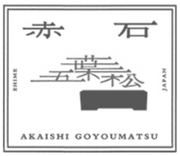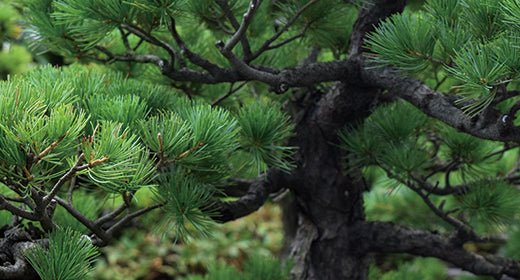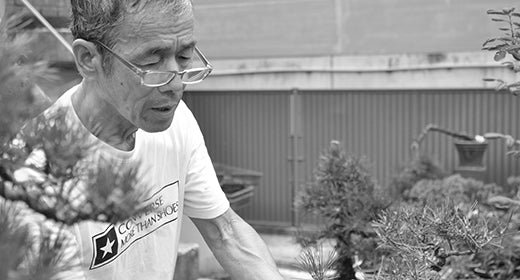The value of Akaishi Goyomatsu backed by history

Akaishi Goyomatsu with over 400 years of history
Akaishi Goyomatsu bonsai has been a specialty of the town of Doi, Shikokuchuo City, Ehime Prefecture, which is located in the Akaishi Mountain Range, since the Azuchi-Momoyama period (1573-1603), and has a history of over 400 years.
Today, about 200,000 Akaishi Goyomatsu, planted from seed and ranging in age from 50 to 70 years, remain in the field.
Meiji to early Showa period
From the beginning of the Meiji era, there were local enthusiasts who made bonsai out of seedlings taken from the mountains.
Bonsai fever first arose from the end of the Taisho era (1912-1926) to the beginning of the Showa era (1926-1989). At that time, people transplanted seedlings from the mountains into the fields, and after two to three years, they were transferred to pots and made into bonsai to be sold. At that time, bonsai cultivation was a sideline for farmers, and no one specialized in it.
Became a full-scale production area in 1955
The demand for Akaishi Goyomatsu began to grow rapidly around 1955, the beginning of Japan's rapid economic growth. With the bonsai boom, many bonsai exhibitions began to be held in various parts of Japan.

In the 1960s, when the production of seedlings began, the cultivation area of Akaishi Goyomatsu in Doi-machi was about 3 ha.
In 1971, the area under cultivation was 11 hectares and the number of cultivators was 150; in 1975, the area was 34 hectares and the number of cultivators was 270; in 1980, the area was 43 hectares and the number of cultivators was 285. Since then, the cultivation area has stagnated, and in 1984 it was 43 ha and 285 households.

From Yamadori to Seedling
In the 1950's, there were many Goyomatsu growing all over Mt. Akaishi, and those picked from the mountain were called "yama-gori" (mountain picking), and traders from the Kanto region frequently came to buy them.
The alpine plants around the summit of Mt. Akaishi were designated as a natural monument by Ehime Prefecture ("Alpine Plants of Mt. Akaishi", December 14, 1957).

As demand increased, the mountain-gathered seedlings were exhausted by around 1959, and the method of collecting seeds in the mountains, growing seedlings from the seeds, and tailoring seedlings changed.
This led to an increase in the collection of pine cones that contained seeds, and overfishing began. In an effort to collect pine cones before others, they began to collect unripe fruits and seeds that did not contain fruits, resulting in overfishing.
As too many seeds were sold and the trees began to grow everywhere, the problem of their rarity and value began to disappear.
Akaishi Goyomatsu Becomes Nationally Recognized
In 1961, the first Akaishi Goyomatsu Exhibition and Sale was held to introduce Akaishi Goyomatsu as a bonsai to the whole country, to expand sales channels and promote the greening movement, as well as to promote local industry.
In 1962, after the 2nd Akaishi Goyomatsu Exhibition and Sale, a dozen or so growers met and established the Akaishi Goyomatsu Association (first president: Mr. Shichisuke Moritaka) to meet the nationwide demand for production and shipment.
With a group of about 10 people, they established a constitution, appointed officers and directors, set the second Sunday of every month as the day for exchange meetings, held a big market and a field market in spring and autumn, and produced a catalog of Akaishi Goyomatsu and its producers to advertise them nationwide.

A vigorous conservation movement begins

In 1963, the Akaishi Goyomatsu Protection Association was formed to protect the endangered Goyomatsu and secure its seeds, as Akaishi Mountain is a preserve of alpine flora and a production area of Goyomatsu.
Local volunteers formed a vigilante group and conducted patrols, checkpoints, and stakeouts at the site day and night. To collect the seeds, they applied for permission from the town's board of education and wore armbands to distinguish those with permission from those without.
Akaishi Goyomatsu attains the highest status
Thanks in part to the active efforts of the cooperative, Akaishi Goyomatsu was well received in many areas, and everyone was making money by selling Goyomatsu seeds all over the country, at a time when one house could stand on the profits.
Around 1955, which was the beginning of Japan's rapid economic growth, the economy was dynamic, including the Jinmu economy, Iwato economy, and the national income doubling policy, and the demand for bonsai was also on the rise.
From the mid-1940's to the mid-1950's, there was a bonsai boom, and demand for Akaishi Goyomatsu increased, and the number of members of the association gradually increased to 64 or 5 at the height of the boom, and people even said, "If you want money, make Goyomatsu.
As the boom in mass sales passed, more and more customers began to pay attention to the foliage and branching of the trees, and began to place orders in the form of "I want this tree".
This led to a change in the way the trees were sold, with many numbered photos in the catalogs, and if the tree was not available, a similar tree would be sold.
Akaishi Goyomatsu, looking to the world but...
With the Tokyo Olympics in 1964 and the Japan World Exposition in 1970, Japan was becoming a more open country, and from the 1950s to the 1960s, the company accepted trainees from Europe.
On the other hand, some clever traders began to climb the Akaishi Mountains and over-harvest the pine trees, saying, "Akaishi Goyomatsu is a world-famous product, let's use this opportunity to sell it to the world.
Eventually, they began to cut down the trees from the roots and harvest the seeds in a rough way, destroying hundreds of years old Goyomatsu.
In 1965, in order to prevent the overcutting and stealing of trees, the police, the Ehime Prefectural Board of Education, and a coalition of related boards of education conducted a simultaneous unannounced crackdown on the harvesting of seeds.
The following year, in 1966, a meeting of the Akaishi Mountain Range Natural Monument Protection Council was held, and it was agreed that the management of the monuments should be further strengthened as a common measure between the government and the protection association.
Akaishi Goyomatsu, a local specialty
Sales of Akaishi Goyomatsu have been strong, and there are high hopes for the future of this agricultural product as a successor to Mikan, a specialty of Ehime Prefecture. In the fall of 1971, as an affiliated organization of the Ehime Prefectural Federation of Economic Organizations and the National Federation of Agricultural Cooperatives for Sales (which merged with the National Federation of Agricultural Cooperatives for Purchasing in 1972 to become the National Federation of Agricultural Cooperatives), mail-order sales began through the Doi-machi Agricultural Cooperative Association, and the product became known nationwide, mainly in the Kanto area centered on Tokyo.
The end of the domestic bonsai boom
In 1976, the Akaishi mountain range was designated as a nature conservation area by Ehime Prefecture, and the collection of young trees in the mountains was banned.
In 1986, at the 60th anniversary of the Showa Emperor's enthronement ceremony in Nippon Budokan, our Akaishi Goyomatsu was selected to stand next to the Emperor on the main stage, adding color to the event.

However, with the end of the bubble economy in the 1990's, which was a period of rapid economic growth and rapid sales of luxury goods, the bonsai boom came to an end.
The demand for bonsai in Japan has been declining and the number of farmers growing bonsai has also been decreasing.
Turning our attention to the world again
The sales of Akaishi Goyomatsu, which had been flourishing in Japan, began to slow down. In the late Showa period (1926-1989), the export of Akaishi Goyomatsu began.
The three companies handling the product were Seitaro Arai Shoten, a trader in Yokohama, Yokohama Ueki Corporation, a gardening company, and Yamato Noen, a company that breeds and sells vegetable seeds. The main export destination was the EU, mostly to the Netherlands.
Gradually, the number of farmers producing vegetables began to decline. At its peak, there were about 300 farmers in the area, but this number has since decreased to about 100.
Succession problems in production areas
The conservation association (Akaishi Alpine Plant Protection Association), which was dissolved after 2001, had about 10 members and was down to less than 10 at the time of dissolution. At that time, there was also talk of carrying out maintenance activities for mountain trails, but since there were no young people joining the association and the founding members had aged as they were, the members were all elderly and it was no longer possible to carry out maintenance activities.
Establishing a Foothold in the World
In an attempt to break through the harsh environment surrounding Akaishi Goyomatsu, an attempt to develop overseas markets began.
In November 2014, with the cooperation of the Japan External Trade Organization (JETRO) and the Ehime and Kagawa offices, we invited buyers from the Kinashi and Kokubunji areas of Takamatsu City, which are famous for their pine bonsai production, to promote Akaishi Goyomatsu.Akaishi Goyomatsu has been gradually gaining a foothold in overseas markets.

In July (August?) of 2019, producers in Shikokuchuo City, Ehime Prefecture, established the Akaishi Goyomatsu Export Promotion Association (Chairman: Junichi Moritaka) to strengthen shipments of Akaishi Goyomatsu to the European market.
In October 2021, Mr. Junichi Moritaka, president of the Akaishi Goyomatsu Export Promotion Association, was granted an audience with Pope Francis at the Vatican City, the headquarters of the Catholic Church, and presented Akaishi Goyomatsu to him. This was the first time that Akaishi Goyomatsu became well known in Europe.

Establishing a foothold in the world
The Akaishi Goyomatsu Export Promotion Association has been preparing for the full-scale export of Akaishi Goyomatsu to Europe, and on the first day of January 2020, they shipped about 150 bonsai trees, ranging in age from 10 to over 100 years, grown by five members of the association.There are prohibitions and quarantines on plants being exported from Japan.

Based on this experience, we are planning to open an exhibition and culture center in Germany.
At present, there are only about 30 farmers left in Shikokuchuo City who grow Goyomatsu. The Akaishi Goyomatsu Bonsai Association, which sells Goyomatsu, still exists, but the number of members, which was over 60 at the time of its establishment, has gradually declined to 42 now that the bonsai boom has subsided.
At the time of its establishment, membership was limited to people from the Doi-machi Sekikawa area, but since the merger with Shikokuchuo City, the qualifications have been eased, and people from Saijo and Niihama have joined, in addition to those from Shikokuchuo City.
Akaishi Goyomatsu in the future
The population is aging, so it is becoming important to train successors.
The situation surrounding bonsai in Japan seems to be severe, but thanks to the steady activities of the Export Promotion Association, we are gradually receiving more and more requests from overseas, and our attempts to develop overseas markets are gradually producing results, and we are now exporting regularly.
The Akaishi Goyomatsu has a history of hundreds of years, with some prosperity and some decline.
After experiencing overhunting of the species and theft of the trees, local producers and volunteers formed a vigilante group to protect the pine trees in the Akaishi mountain range.
The Akaishi Goyomatsu has enough elements to be introduced to the world.
The Akaishi Goyomatsu has started up again, inheriting not only the tree itself, but also the tradition and spirit of its predecessors.
The Akaishi Goyomatsu is the successor to the Goyomatsu that our predecessors protected.
As many as 200,000 Akaishi Goyomatsu, about 50 years old from seedlings, have been carefully nurtured by the growers and are waiting for their time of surrender in the field.




